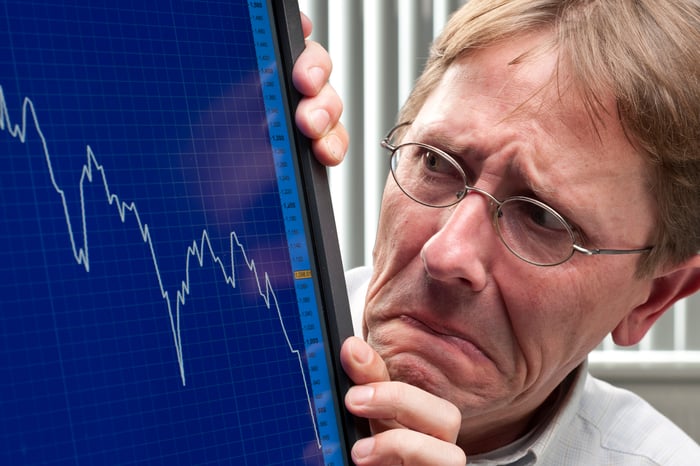This has been a challenging year all the way around for the investing community. Since notching their respective all-time highs between mid-November and the first week of January, the ageless Dow Jones Industrial Average (^DJI -0.11%), widely followed S&P 500 (^GSPC 0.02%), and innovation-driven Nasdaq Composite (^IXIC 0.10%) have all plummeted into a bear market. The bond market hasn't provided much of a safety net, either, with bonds delivering what may well be their worst year in history!
The good news -- if there's any to be found among this market tumult -- is that every substantive decline in the major U.S. stock indexes has always represented a buying opportunity for patient investors. But this doesn't change the fact that heightened volatility and the growing prospect of a U.S. recession has investors on edge and wondering, "When will the bear market bottom?"

Image source: Getty Images.
Multiple metrics suggest the stock market is headed lower
Over the past couple of months, I've highlighted a number of indicators that have had solid success at calling previous bear market bottoms.
For example, outstanding margin debt has an uncanny track record of predicting bear markets. Margin debt being the amount of money borrowed from brokerages with interest to purchase or short-sell securities. When the amount of margin debt rises rapidly, it's often a sign of increased risk-taking by investors -- and an ominous warning for the stock market.
In the three instances since the beginning of 1995 where margin debt rocketed higher by 60% or more in a trailing-12-month (TTM) period, the stock market peaked not long thereafter and entered a bear market. Margin debt plummeted by more than 40% on a TTM basis to signal bottoms for each of the previous two bear markets (2002 and 2009). The current TTM decline in outstanding margin debt is a little over 20%, implying more downside to come.
Valuation-based indicators have signaled additional downside is likely, too. The S&P 500 Shiller price-to-earnings ratio (also known as the cyclically adjusted price-to-earnings ratio, or CAPE ratio) has accurately predicted bear markets five times since 1870. More importantly, a number of previous double-digit percentage declines found their respective bottoms around a Shiller P/E of 22. The current Shiller P/E is still above 27.
Further, the S&P 500's forward price-to-earnings ratio is still marginally higher than the 13 to 14 multiple that has signaled the bottom for a number of pullbacks over the past quarter of a century.
Here's the indicator I'm watching closest to help identify a bottom
However, none of these aforementioned indicators is my absolute favorite when it comes to predicting bear market bottoms.
To be clear, there is no such thing as a perfect predictor of bear market bottoms. If there was, you can rest assured that everyone from Wall Street professionals to everyday investors would be using it by now. Nevertheless, this particular metric has proved quite useful during double-digit percentage declines over the past two decades. I'm talking about analyzing the percentage of stocks in the Nasdaq Composite trading above their 200-day moving average.
Moving averages are used by technical analysts who believe the average price of a stock over a given period provides some form of support. But I'm not thinking of this indicator in this respect. Rather, I'm using the percentage of stocks within the index (Nasdaq) that's led the market higher and lower for the past quarter of a century as a gauge of investor sentiment.
Historically, investors have a tendency to become overly optimistic during bull markets and push valuations into the stratosphere. Likewise, they can become overly bearish and overshoot to the downside during short periods of pessimism. This indicator helps recognize when those peak periods of pessimism arrive and are a signal for investors to pounce.
Over the past 20 years, there have been six instances where roughly 12% or fewer of all Nasdaq-listed stocks were above their 200-day moving average. This includes the 2002 dot-com bubble bottom (12.12%); 2009 Great Recession bottom (5.23%); first quarter pullback in 2016 (11.29%); fourth quarter of 2018 pullback (10.11%); COVID-19 crash bottom (7.01%), and June 2022 (8.81%). Although predicting precisely where this metric will bottom is impossible, a value of 12% or less has historically represented an incredible buying opportunity and has pretty closely called most bear market bottoms.
As of this writing, following the close of business on Oct. 17, 2022, only 22% of Nasdaq-listed companies were above their 200-day moving average.

Image source: Getty Images.
Buying stocks during bear markets is a genius move -- here's why
But just because I'm keeping a close eye on this bear market bottom indicator, it doesn't mean I haven't been putting money to work on a regular basis during this downturn. That's because any double-digit percentage decline in the broader market is, historically, a smart time to invest -- at least for long-term investors.
As I've previously pointed out, market analytics company Crestmont Research publishes the rolling 20-year total returns, including dividends paid, of the S&P 500 every year. For example, the rolling 20-year total return for 1997 would include years 1978 through 1997 and include all dividends paid.
In total, Crestmont has examined 103 end years (1919-2021), which means it's evaluated every 20-year holding period since 1900 for the S&P 500. The key takeaway is that no 20-year rolling period has produced a negative total return. Whereas you can count on one hand how many end years finished with an annual average total return of 5% or less over 20 years, there are around 40 ending years where the average annual total return over two decades was 10.9% at minimum.
Patience has continually paid off handsomely for investors, which is why you're a genius if you're putting your money to work during this significant bear market downturn.




